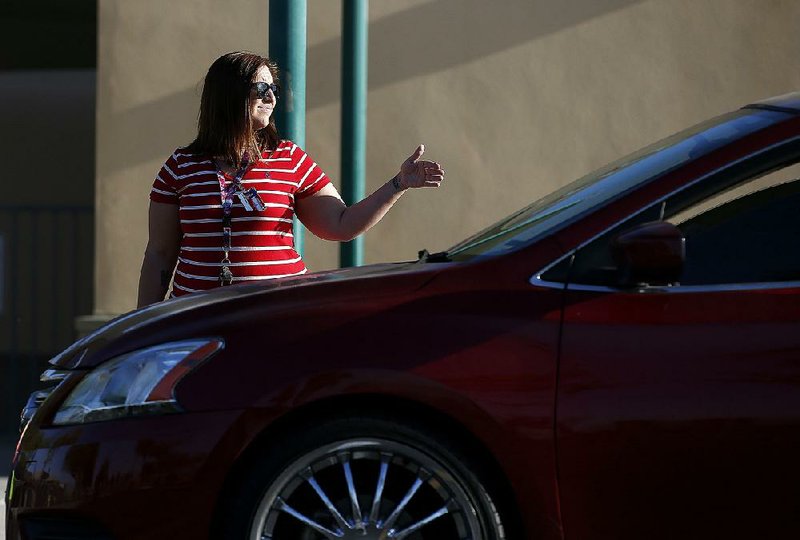OKLAHOMA CITY -- Hundreds of thousands of American schoolteachers -- about 18 percent -- work second jobs to boost their income, according to the latest survey from the U.S. Education Department.
Those jobs supplement the average full-time teacher salary of $55,100 by an average of $5,100, according to the survey from the 2015-16 school year, the most recent available.
Teaching is hardly the only profession where people pick up second jobs to pay their bills, and many have the flexibility to do other work in the summer when school is out. But those numbers -- up from 16 percent in 2011-12 -- help explain the anger behind teacher revolts in states including West Virginia, Oklahoma and Kentucky.
After a day of instructing first-graders at Oologah-Talala Public Schools in Oklahoma, Melinda Dale puts on a janitor's uniform and begins cleaning the building.
"I usually do it right after school," Dale said, "because working with first grade all day, I tend to lose my energy pretty fast."
Dale, who has taught for six years, earns $32,000 a year as a teacher. She spends about 15 hours a week on the janitorial work at $10 an hour.
She is trying to save money for college for the oldest of her three children, a high school senior. Her youngest, a first-grader, has to wait for Dale to finish cleaning before she can go home, but sometimes other family members help with the cleaning so she can leave sooner and spend time with her kids.
Her second job forces her to do lesson plans on the weekend, usually on Sundays after church and lunch with her family.
One day, her seventh-grade daughter was waiting in the car for her mother and said: "I'm sorry it's come to this, Mom."
"It was a very heartwarming but sad moment to hear her say those words," Dale said. "I'll do whatever it takes to be in the career that I'm in, but also provide for them."
In the metro Phoenix area, Stefanie Lowe works as a Lyft driver. She says many of her passengers in her Jeep are surprised to learn that she is also a full-time teacher.
"It's super-busy to drive during the week, but sometimes I just have to do it," said Lowe, 28.
She earns just under $37,000 as a first-grade teacher at Tuscano Elementary School. She rents a room, instead of having her own apartment, to keep her housing costs down, but to make ends meet she drives for Lyft on nights and weekends and also picks up tutoring jobs. She drives more during the week when she has upcoming expenses like a car registration payment, medical bills or supplies for her classroom.
By 7 a.m. the next school day, she's back at her classroom with her 32 students. Lowe said she's committed to improving their lives.
"These kids are going to be taking care of you when you're older," she said. "Let's educate them; let's make them the best people that they can be."
Lowe left a job in health care in Pennsylvania to teach in Arizona, where the signing bonus from her first job at a low-income Tucson-area school went entirely toward materials for her classroom.
"I went to school for this to be my career," Lowe said, "not so I could work three jobs just to be able to afford to go the doctor."
In West Virginia, Christi Phillips keeps up her longtime second career as a children's photographer despite more than three decades of teaching experience. She enjoys working both jobs, but she feels like she doesn't really have a choice.
"Thirty-two years, I have to have a second job," said Phillips, who teaches first grade at George Ward Elementary School in Mill Creek. "Isn't that sad? That's very sad. Everybody I know has two or three."
Phillips makes $52,000 teaching. That's enough, she says, for her utilities and a car payment. The money from the second job is needed if she and her husband want to eat out at a nice restaurant, buy a second vehicle or take a vacation.
"I can scrape by. I can make do on my salary if I just want to pay bills. That's it," Phillips said. "If I want to live, if I want to do any real living, I can't do it on my salary."
West Virginia teachers, who rank among the nation's lowest paid, received a 5 percent raise after a statewide strike in February. It set the stage for teacher protests in other states.
"A lot of people think, 'Woo, you make tons of money,'" Phillips said. "If you compare my salary to maybe somebody who works in fast food, I do. But if you compare my salary to somebody who works, say, at our local hardwood plant here, not so great. There's people there probably making as much as I am without the education, without the years of service."
A Section on 04/16/2018

